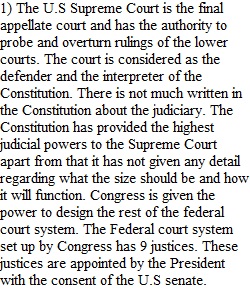


Q While we often hear complaints of “liberal, activist courts” in the popular media, the ideological balance of the Court is much less clear. Explore the ideological balance of the U.S. Supreme Court in your debate journal. 1. Begin by reading Ch. 14, "The Courts" , then research the official Supreme Court website (Links to an external site.). Even more history and background is provided by C-Span featured videos here: C-Span: The Supreme Court: Home to America's Highest Court (Links to an external site.) (Also view related videos below the Featured Video.) 2. For your debate journal, list how many and who makes up the current Supreme Court today. Then, answer the following: • o Who is the Chief Justice? o Who is considered conservative? o Who is considered liberal? o Who is the swing vote? o Who is the oldest? o Who is the youngest? o Why do you think religion is listed? o How great a role does merit play in the selection of Supreme Court justices? 3. Do the current justices meet the highest standards of experience and expertise, or have the ideological preferences of presidents led to the choosing of less qualified justices? Please include any external links to cite your research. Rubric POL 300 Journal Rubric POL 300 Journal Rubric Criteria Ratings Pts This criterion is linked to a Learning OutcomePreparation 25 to >23.0 pts Distinguished Journal entry shows evidence of thorough preparation through reading or reflection. Author speaks as one who has knowledge to share. 23 to >20.75 pts Proficient Journal entry shows evidence of preparation through reading or reflection. Author speaks as one who has knowledge to share. 20.75 to >18.75 pts Satisfactory Journal entry shows some evidence of preparation through reading or reflection. Author demonstrates some knowledge applicable to prompt. 18.75 to >16.25 pts Marginal Journal entry shows little evidence of preparation through reading or reflection. 16.25 to >0 pts Unsatisfactory Journal entry shows no evidence of preparation through reading or reflection. 25 pts This criterion is linked to a Learning OutcomeQuality of content 25 to >23.0 pts Distinguished Journal entry contains substantial information for reader. The entry addresses the focus question(s) completely. 23 to >20.75 pts Proficient Journal entry contains substantial information for reader. The entry addresses the focus question(s). 20.75 to >18.75 pts Satisfactory Journal entry contains some relevant information for reader. The entry addresses the focus question(s). 18.75 to >16.25 pts Marginal Journal entry contains minimal information for reader. The entry addresses the focus question(s) weakly. 16.25 to >0 pts Unsatisfactory Journal entry contains minimal information for reader. The entry does not address the focus question(s). 25 pts This criterion is linked to a Learning OutcomePersonal reflection 25 to >23.0 pts Distinguished Journal entry conveys extensive evidence of a personal response to the focus question(s); demonstrates the author's growth through reflection on learning. 23 to >20.75 pts Proficient Journal entry conveys evidence of a personal response to the focus question(s); demonstrates the author is capable of reflecting on learning. 20.75 to >18.75 pts Satisfactory Journal entry conveys evidence of a personal response to the focus question(s) with a few gaps in clarity; demonstrates the author is capable of some reflection on learning. 18.75 to >16.25 pts Marginal Journal entry conveys little evidence of a personal response to the focus question(s). 16.25 to >0 pts Unsatisfactory Journal entry shows no personal response to the focus question(s). 25 pts This criterion is linked to a Learning OutcomeConventions 25 to >23.0 pts Distinguished Journal entry shows few, if any errors in standard written English that do not interfered with understanding. 23 to >20.75 pts Proficient Journal entry may have some errors in standard written English that rarely interfere with understanding. 20.75 to >18.75 pts Satisfactory Journal entry has a few errors in standard written English that may interfere with understanding. 18.75 to >16.25 pts Marginal Journal entry has several kinds of errors in standard written English that interfere with understanding. 16.25 to >0 pts Unsatisfactory Journal entry has frequent and severe errors in standard written English that interfere with understanding. 25 pts Total Points: 100 PreviousNext
View Related Questions